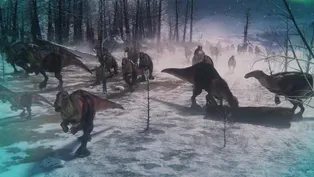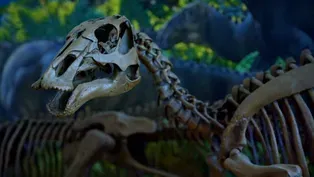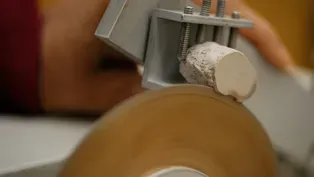
What Did Dinosaurs in Alaska Eat During Winter?
Clip: Season 48 Episode 21 | 2m 36sVideo has Closed Captions
During the winter months, food for the plant eaters would have withered or died.
During the Cretaceous, Alaska was even farther north than it is today and part of the state would have experienced four months of total darkness.
Problems with Closed Captions? Closed Captioning Feedback
Problems with Closed Captions? Closed Captioning Feedback
National Corporate funding for NOVA is provided by Carlisle Companies. Major funding for NOVA is provided by the NOVA Science Trust, the Corporation for Public Broadcasting, and PBS viewers.

What Did Dinosaurs in Alaska Eat During Winter?
Clip: Season 48 Episode 21 | 2m 36sVideo has Closed Captions
During the Cretaceous, Alaska was even farther north than it is today and part of the state would have experienced four months of total darkness.
Problems with Closed Captions? Closed Captioning Feedback
How to Watch NOVA
NOVA is available to stream on pbs.org and the free PBS App, available on iPhone, Apple TV, Android TV, Android smartphones, Amazon Fire TV, Amazon Fire Tablet, Roku, Samsung Smart TV, and Vizio.
Buy Now

NOVA Labs
NOVA Labs is a free digital platform that engages teens and lifelong learners in games and interactives that foster authentic scientific exploration. Participants take part in real-world investigations by visualizing, analyzing, and playing with the same data that scientists use.Providing Support for PBS.org
Learn Moreabout PBS online sponsorship- [Narrator] Alaska is the last place on Earth one might expect to find large reptiles, but the discovery of fossils has revealed dinosaurs could live farther north than what was once thought possible.
Now, this team hopes to answer some fundamental questions.
- What kind of animals lived here?
How did they survive the arctic winters?
- Where did they get their food?
- [Narrator] During these winter months, food for the plant eaters would've withered or died.
Karen Chin is one of the world's leading experts in dinosaur dung.
She's been investigating hadrosaur diet by studying the fossilized remains of their feces, known as coprolites.
(upbeat music) (machine hums) - [Narrator] At 100 times magnification, even the individual fossilized cells of the dinosaur's last meal are visible.
Investigating coprolites from non-polar dinosaurs living in southern Utah and Montana, Karen finds something intriguing.
- We can see chunks of intact wood, and that's where you see all of the cells are almost glued together.
They're glued together with lignin.
But then you can also see all of these loose cells all over the place in no particular order scattered all around.
And that indicates rotting wood.
To break down lignin, it requires oxygen.
So that can't happen in an animal's gut.
It has to happen outside where there's access to oxygen.
So we know that the wood was degraded, decomposed before it was ingested by the dinosaur.
I was quite surprised.
Why were they eating so much wood?
- [Narrator] The incredible new evidence suggests the southern hadrosaurs could diversify their diets, feeding on rotting wood to survive.
- Where are you gonna get protein if you're a herbivore?
You can go to a rotting log where there's lots of creepy crawlers, like beetles and millipedes, and pill bugs.
(bugs scatter across wood) - [Narrator] It raises the tantalizing possibility that this could have been a winter food source for Alaskan dinosaurs as well.
Video has Closed Captions
Preview: S48 Ep21 | 29s | Intrepid paleontologists discover that dinosaurs thrived in the Arctic’s cold and dark. (29s)
Did Some Dinosaurs Breed in the Arctic?
Video has Closed Captions
Clip: S48 Ep21 | 3m | 70 million years ago, several species of dinosaur nested in the Arctic. (3m)
Fossilized Dung Reveals Clues About Dinosaurs' Diet
Video has Closed Captions
Clip: S48 Ep21 | 3m 6s | Where are you going to get protein if you're an herbivore? (3m 6s)
Providing Support for PBS.org
Learn Moreabout PBS online sponsorshipSupport for PBS provided by:
National Corporate funding for NOVA is provided by Carlisle Companies. Major funding for NOVA is provided by the NOVA Science Trust, the Corporation for Public Broadcasting, and PBS viewers.















